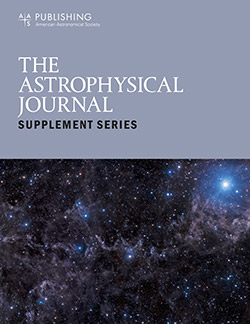Deciphering the Morphological Origins of X-shaped Radio Galaxies: Numerical Modeling of Backflow versus Jet Reorientation
IF 8.5
1区 物理与天体物理
Q1 ASTRONOMY & ASTROPHYSICS
引用次数: 0
Abstract
Abstract X-shaped radio galaxies (XRGs) develop when certain extragalactic jets deviate from their propagation path. An asymmetric ambient medium (backflow model) or complex active galactic nucleus activity (jet-reorientation model) enforcing the jet direction to deviate may cause these structures. In this context, the present investigation focuses on the modeling of XRGs by performing 3D relativistic magnetohydrodynamic simulations. We implement different jet-propagation models applying an initially identical jet-ambient medium configuration to understand distinctive features. This study, the first of its kind, demonstrates that all adopted models produce XRGs with notable properties, thereby challenging the notion of a universal model. Jet reorientation naturally explains several contentious properties of XRGs, including wing alignment along the ambient medium’s primary axis, development of collimated lobes, and the formation of noticeably longer wings than active lobes. These XRGs disrupt the cluster medium by generating isotropic shocks and channeling more energy than in the backflow scenario. Our synthetic thermal X-ray maps of the cluster medium reveal four clear elongated cavities associated with the wing-lobe alignment, regardless of projection effects, but they affect their age estimation. We show that the depth and geometric alignment of the evolved cavities may qualify as promising characteristics of XRGs, which may be used to disentangle different formation scenarios.解密x形射电星系的形态起源:回流与喷流重新定向的数值模拟
x型射电星系(XRGs)是由某些河外喷流偏离其传播路径而形成的。不对称的环境介质(回流模型)或复杂的活跃星系核活动(喷流重新定向模型)可能导致喷流方向偏离。在此背景下,本研究的重点是通过进行三维相对论磁流体动力学模拟来对XRGs进行建模。我们应用最初相同的射流-环境介质配置实现了不同的射流传播模型,以了解不同的特征。该研究首次证明,所有采用的模型都会产生具有显著属性的xrg,从而挑战了通用模型的概念。射流重新定向自然地解释了XRGs的几个有争议的特性,包括沿环境介质主轴的机翼对齐,准直叶的发展,以及明显长于活动叶的机翼的形成。这些XRGs通过产生各向同性冲击来破坏簇介质,并比回流情况下引导更多的能量。我们的星团介质的合成热x射线图显示了四个与翼叶排列相关的清晰的细长空腔,不考虑投影效应,但它们影响了它们的年龄估计。我们表明,演化的空腔的深度和几何排列可能符合XRGs的有前途的特征,可以用来解开不同的形成场景。
本文章由计算机程序翻译,如有差异,请以英文原文为准。
求助全文
约1分钟内获得全文
求助全文
来源期刊

Astrophysical Journal Supplement Series
地学天文-天文与天体物理
CiteScore
14.50
自引率
5.70%
发文量
264
审稿时长
2 months
期刊介绍:
The Astrophysical Journal Supplement (ApJS) serves as an open-access journal that publishes significant articles featuring extensive data or calculations in the field of astrophysics. It also facilitates Special Issues, presenting thematically related papers simultaneously in a single volume.
 求助内容:
求助内容: 应助结果提醒方式:
应助结果提醒方式:


